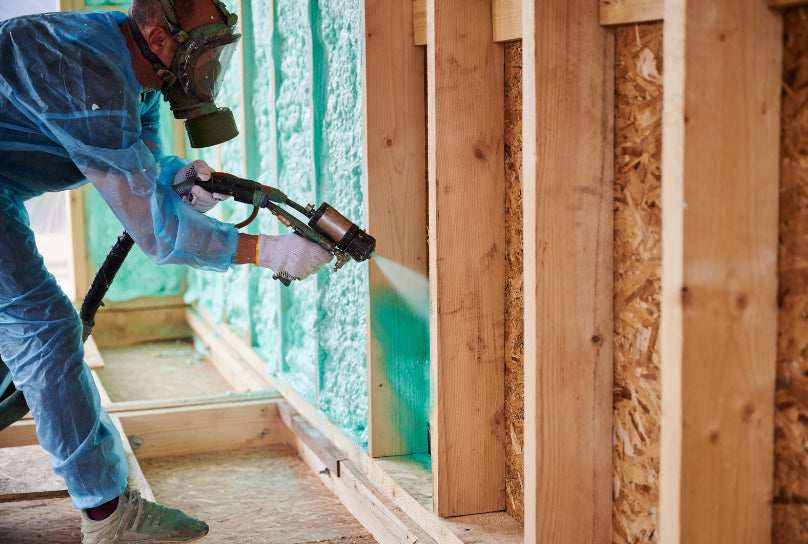Is Dried Spray Foam Insulation Flammable?
When it comes to insulating homes and buildings, spray foam insulation has gained popularity for its effectiveness and energy-saving capabilities. However, there are concerns about the flammability of this insulation material, especially after it has dried. In this article, we will explore the flammability of dried spray foam insulation and address the potential risks and safety concerns associated with its use.
Spray foam insulation is known for its excellent insulating properties, but its flammability remains a major consideration for homeowners and builders. While the initial application process involves spraying a mixture that expands and solidifies, the foam continues to cure over time, becoming hard and rigid. It is during this curing process that the flammable properties of the spray foam insulation can be a potential concern.
One of the main risks of spray foam insulation flammability is the combustibility of cured foam. Once the foam has fully cured, it can become highly flammable if exposed to an ignition source. This means that if a fire were to occur in a building where spray foam insulation is installed, the cured foam could contribute to the spread and intensity of the fire.
Additionally, there are fire hazards associated with spray foam insulation that should be taken into consideration. The foam itself can release hazardous smoke and toxic gases when exposed to fire. This can pose a threat to occupants and firefighters in the event of a fire incident.
Given these concerns, it is important to address the safety aspects of spray foam insulation. Understanding the risks and taking appropriate precautions can help mitigate potential hazards. Building codes and regulations may also exist to ensure the safe installation and use of spray foam insulation.
In the following sections of this article, we will further explore spray foam insulation's fire resistance properties, evaluate the fire risks associated with its use, and compare its flammability to other building materials. By gaining a comprehensive understanding of the flammability aspects of spray foam insulation, you can make informed decisions to ensure the safety of your home or building.
Read more: Is Closed Cell Foam Flammable?
Understanding Spray Foam Insulation Fire Resistance
When it comes to construction materials, fire resistance is a crucial factor to consider in ensuring the safety and longevity of a building. In this section, we will delve into the fire resistance properties of spray foam insulation. Understanding the flammable properties of spray foam insulation is essential for making informed decisions regarding its application and complying with fire safety regulations.
Flammable Properties of Spray Foam Insulation
Spray foam insulation, like any other material, has flammable properties that need to be taken into account during installation and use. Although spray foam insulation is not inherently flammable, it can become a potential fire hazard if exposed to an ignition source.
It is crucial to follow proper installation procedures and ensure that all necessary safety precautions are taken to minimize the risk of fire accidents. Additionally, spray foam insulation fire safety regulations may be in place to ensure its safe installation and use, as outlined by local building codes and standards.
Read More: Is Spray Foam Insulation a Good Idea?
Fireproofing Insulation and its Relevance to Spray Foam
The concept of fireproofing insulation involves adding an extra layer of protection to minimize the spread of fire within a building. While spray foam insulation on its own may not be entirely fireproof, it can be part of a comprehensive fireproofing system when used in conjunction with other fire-resistant materials.
Fireproofing insulation aims to provide additional time for occupants to safely evacuate a building during a fire, while also protecting the structural integrity of the building. When considering the fire resistance of spray foam insulation, it is essential to understand how it can be integrated into an overall fireproofing strategy.
By understanding the fire resistance properties and flammable properties of spray foam insulation, along with complying with fire safety regulations, it is possible to enhance the safety of buildings and minimize the risk of fire accidents. Next, we will move on to evaluating the fire risks associated with spray foam insulation and compare it to other building materials.
Read More: Spray Foam Insulation Cost
Evaluating the Fire Risks of Spray Foam Insulation
In this section, we will carefully evaluate the fire risks associated with spray foam insulation. Safety is of utmost importance when it comes to choosing insulation materials for your home. So, let's address the crucial aspects of fire safety and the potential risks posed by spray foam insulation.
One of the primary concerns is whether or not spray foam insulation can ignite. Understanding the flammability of this material is essential for determining its suitability. While spray foam insulation is relatively safe to use, it is crucial to follow proper installation and safety guidelines to minimize any potential risks.
Comparing the flammability of spray foam insulation to other building materials, such as drywall, can provide a broader perspective. Drywall is susceptible to catching fire and can contribute to the spread of flames. On the other hand, spray foam insulation has fire-resistant properties that can help contain fires within a confined area.
To further ensure the safety of spray foam insulation, fire safety regulations are put in place. These regulations outline specific guidelines and requirements for the installation and use of spray foam insulation in various applications. Adhering to these regulations is essential to mitigate any potential fire hazards.
Overall, it is important to remember that spray foam insulation, when properly installed and used in compliance with fire safety regulations, can provide effective insulation while minimizing fire risks. By understanding these fire risks and taking necessary precautions, you can confidently choose spray foam insulation for your home.
Read More: The Ultimate Spray Foam Insulation Buying Guide
Conclusion
After examining the flammability of dried spray foam insulation, it is essential to address the risks and safety concerns associated with its use. While spray foam insulation itself is not flammable after it dries, it can pose fire hazards if not properly installed or in specific conditions.
One of the critical factors in ensuring the safety of spray foam insulation is its fire resistance properties. With proper installation and adherence to fire safety regulations, spray foam insulation can offer effective protection against fire risks. However, it is crucial to understand that fireproofing insulation is necessary to enhance its overall fire resistance.
When evaluating the fire risks of spray foam insulation, it is important to consider other building materials in comparison. While drywall is generally not considered flammable, it can still contribute to the spread of fire. Therefore, using spray foam insulation in combination with fire-resistant materials can provide enhanced safety measures for your home.
In conclusion, spray foam insulation is generally safe and not flammable after it dries. However, it is crucial to address the potential risks and safety concerns associated with improper installation and specific conditions. By understanding the fire resistance properties, evaluating the fire risks, and combining spray foam insulation with fire-resistant materials, you can ensure the safety of your home and minimize any potential fire hazards.
FAQ
Is spray foam insulation flammable after it dries?
Spray foam insulation is not flammable after it dries. Once the foam has fully cured, it forms a fire-resistant barrier that helps prevent the spread of flames. However, it is important to note that spray foam insulation can combust if exposed to high temperatures or an open flame during installation or before it has fully cured.
What are the risks of spray foam insulation flammability?
While spray foam insulation is generally considered safe and is designed to resist flames, there are some risks associated with its flammability. During installation, if the foam comes into contact with an ignition source, it can catch fire. Additionally, improperly installed or damaged spray foam insulation may increase the risk of fire spreading within a building. Therefore, it is crucial to follow proper installation procedures and inspect the foam for any signs of damage.
Are there any safety concerns with spray foam insulation?
There are some safety concerns with spray foam insulation. It releases chemicals called volatile organic compounds (VOCs) during application, which can cause respiratory irritation and other health issues if not properly ventilated. It is essential to ensure adequate ventilation during and after installation to minimize any potential health risks. Additionally, as with any insulation material, proper fire safety precautions should be followed to prevent the risk of fire.
Is spray foam insulation fireproof?
While spray foam insulation has fire-resistant properties, it is not entirely fireproof. It can withstand flames for a certain period, but prolonged exposure to high temperatures or intense flames can cause the foam to burn. Therefore, it is important to follow fire safety regulations and consider additional fireproofing measures for enhanced protection, such as installing fire-resistant drywall or applying intumescent coatings to the foam.
How does spray foam insulation compare to other building materials in terms of flammability?
Spray foam insulation has better fire resistance properties compared to materials like traditional fiberglass insulation or untreated wood. It forms a sealed barrier that can help prevent the spread of flames and reduce the risk of fire-related damage. However, it is essential to note that other building materials, such as drywall, can also contribute to the flammability of a structure. Therefore, it is crucial to consider the overall fire safety measures and use appropriate fire-rated materials when necessary.




